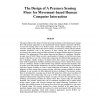Free Online Productivity Tools
i2Speak
i2Symbol
i2OCR
iTex2Img
iWeb2Print
iWeb2Shot
i2Type
iPdf2Split
iPdf2Merge
i2Bopomofo
i2Arabic
i2Style
i2Image
i2PDF
iLatex2Rtf
Sci2ools
EUROSSC
2007
Springer
2007
Springer
The Design of a Pressure Sensing Floor for Movement-Based Human Computer Interaction
This paper addresses the design of a large area, high resolution, networked pressure sensing floor with primary application in movement-based human-computer interaction (M-HCI). To meet the sensing needs of an M-HCI system, several design challenges need to be overcome. Firstly, high frame rate and low latency are required to ensure real-time human computer interaction, even in the presence of large sensing area (for unconstrained movement in the capture space) and high resolution (to support detailed analysis of pressure patterns). The optimization of floor system frame rate and latency is a challenge. Secondly, in many cases of M-HCI there are only a small number of subjects on the floor and a large portion of the floor is not active. Proper data compression for efficient data transmission is also a challenge. Thirdly, locations of disjoint active floor regions are useful features in many M-HCI applications. Reliable clustering and tracking of active disjoint floor regions poses as ...
| Added | 07 Jun 2010 |
| Updated | 07 Jun 2010 |
| Type | Conference |
| Year | 2007 |
| Where | EUROSSC |
| Authors | Sankar Rangarajan, Assegid Kidané, Gang Qian, Stjepan Rajko, David Birchfield |
Comments (0)

